- Home >
- Social Responsibility >
- About Employees >
- Health Management and Occupational Safety and Health
Health Management and Occupational Safety and Health
Improvement of employee health
Basic Concept
The founder of Dai-ichi Life, Tsuneta Yano, said, "Give full consideration to the health and hygiene of your employees." Therefore, since the company's founding, our group has fostered a culture that values the health of our employees. Furthermore, through our life insurance business and other activities, we have been conducting business that contributes to the health of not only our employees, but also our customers and local communities. We will continue to practice health management based on the spirit of our founding, and contribute to the health and well-being of each and every one of our employees.
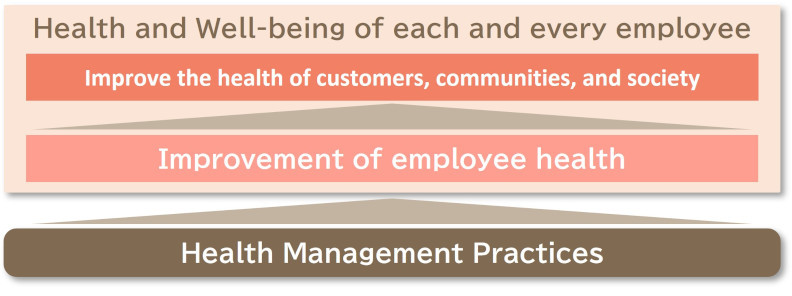
Health Management Statement
The Dai-ichi Life Group has made clear both internally and externally its commitment to promoting health management by establishing "Dai-ichi Life Group Health Statement" in 2011 and the Basic Policy on Health Promotion in 2013. We will continue to contribute to the health and well-being of each and every one of our employees based on "the Group Code of Conduct" and "Dai-ichi Life Group Health Management Statement", which were both updated in 2024.
< Dai-ichi Life Group Health Management Statement >
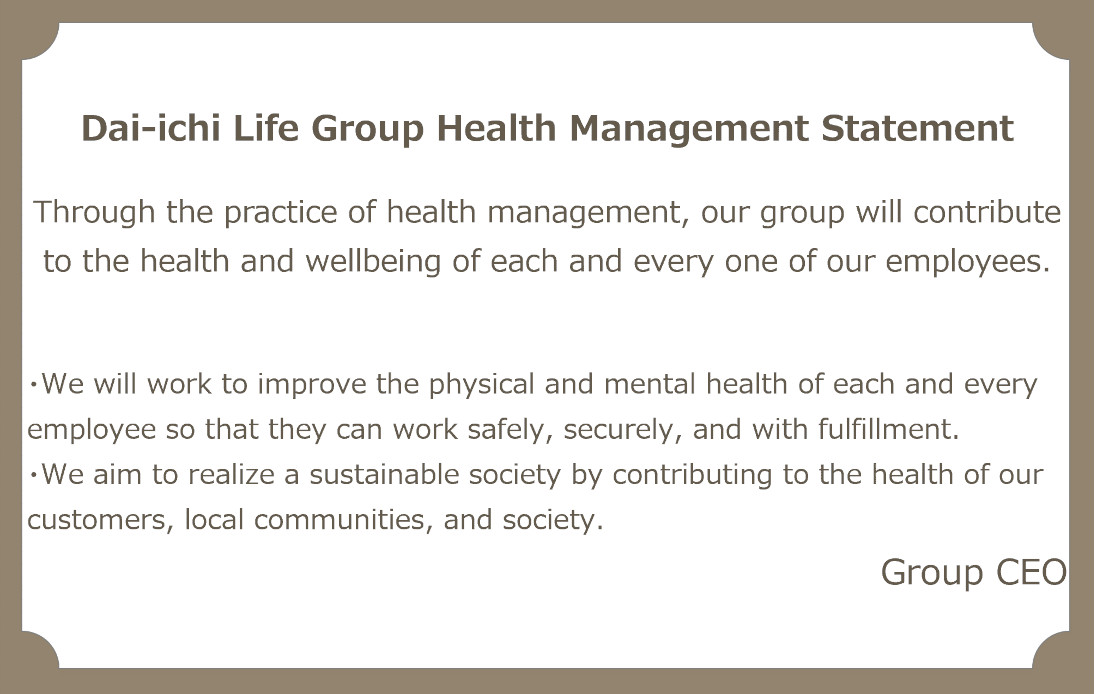
Promotion System
Under the leadership of the G-CHRO, we are working to improve the level of initiatives led by the person in charge of health management promotion in the Human Resources Unit.
Specifically, we are promoting various measures based on health issues by collaborating with internal and group companies, health insurance unions, worker representatives, and others, and by implementing the PDCA cycle. In addition, each business site has a person in charge of promoting occupational health and safety activities and health promotion initiatives, such as a work management supervisor and health supervisor, who work together with industrial physicians, public health nurses, and the Health Promotion Group Secretariat to implement initiatives. The PDCA cycle is used to promote health management initiatives and the improvement of occupational health and safety by regularly consulting with the G-CHRO, various committees, health insurance association meetings, health committee, worker representatives, etc., regarding health issues, measures, promotion status, etc. Group Chief Sustainability Officer chairs the Group Sustainability Committee, which reports on health management initiatives and implements the PDCA cycle. Members of the Health Promotion Group are also working to enhance their expertise by acquiring qualifications as occupational health consultants and health management expert advisors.
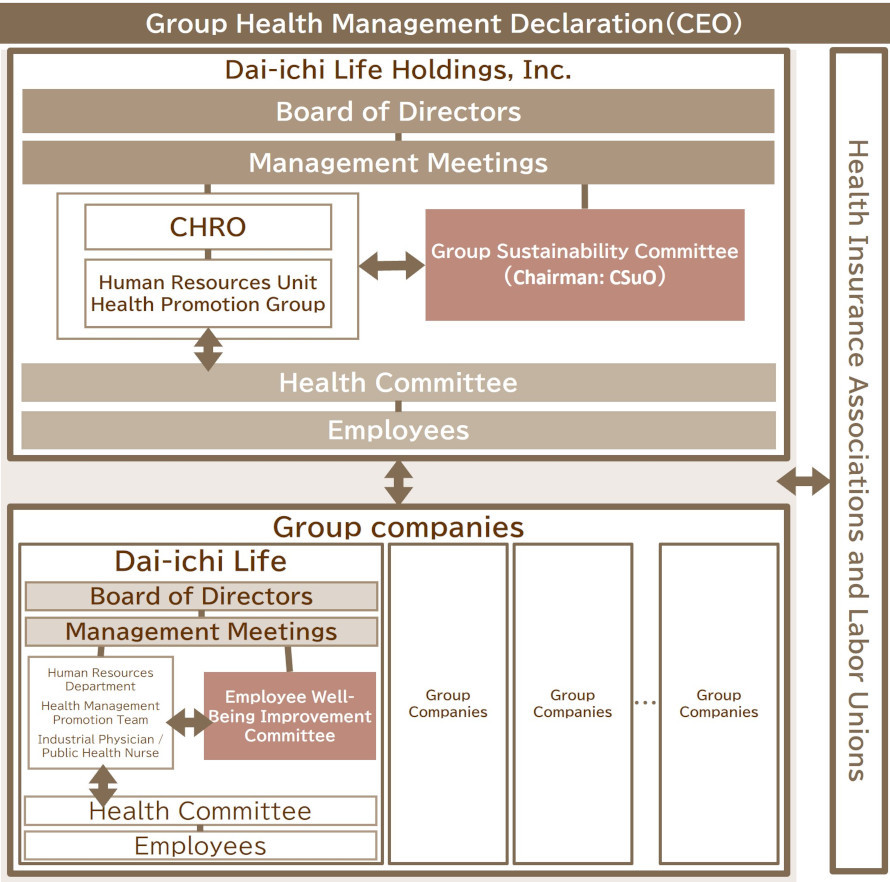
Connection Goals and Measures
The Dai-ichi Life Group aims to realize employee well-being, striving for a workplace where "every employee is healthy, takes pride in their work, finds fulfillment, and can thrive authentically alongside their colleagues." We have established "improving presenteeism" and "enhancing engagement" as Key Goal Indicators (KGIs) to measure the outcomes of our health management initiatives. Based on our health management strategy map, we are implementing specific measures to achieve these goals. In addition, based on the concept of occupational health and safety management system, we are working on measures to ensure, maintain, and improve a healthy and safe working environment. In order to enhance the effectiveness of these measures, we implement the PDCA cycle and conduct periodic reviews, including the effectiveness of the measures, to promote the improvement of the level of health and occupational safety and health of our employees and the organization. In addition, we regularly identify and assess risks related to occupational health and safety, such as accidents, incidents, diseases, and pandemics. We prioritize countermeasures against significant risks identified through this process, and work to prevent recurrence by implementing a PDCA cycle for health measures, including collaboration or consultation with the CHRO and related committees, and by providing regular training and information on accident prevention to employees.
< Health Management Strategy Map >
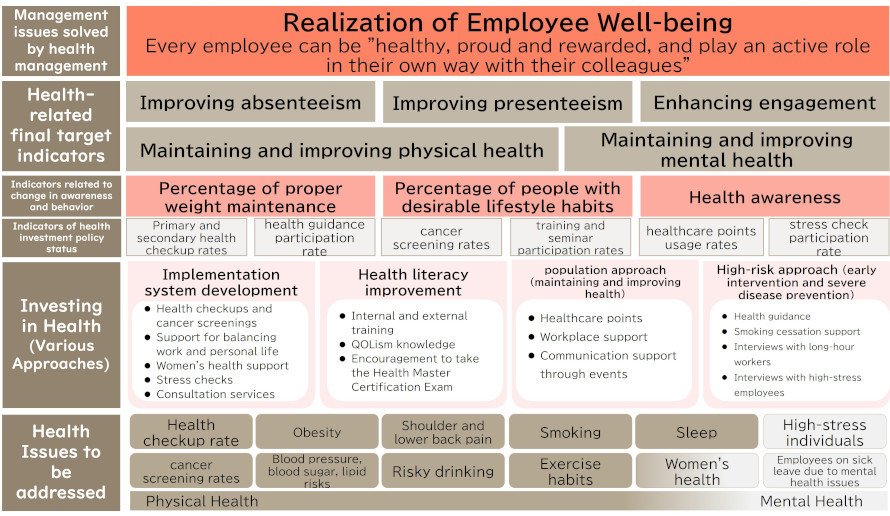
Key Initiatives
We believe that for each employee to work with a sense of "fulfillment" and "purpose," it is crucial to lead a healthy daily life. Therefore, we are continuously working towards implementing health management practices. Led by the management team, we aim to create a workplace with high psychological safety, where every employee can be themselves and perform to their fullest potential.
Moreover, the rapid changes in work styles, triggered by telework and other factors in recent years, have led to an increase in lifestyle disease risks and changes in workplace communication. Consequently, we have identified "Lifestyle Disease Prevention" and "Mental Health Measures" as our key initiatives. We are dedicated to these initiatives to achieve employee well-being.
Initiatives
Health Examination/Health Guidance
We are working on early response to lifestyle-related diseases and prevention of serious illnesses by thoroughly recommending employees to undergo reexamination after regular health checkups and health guidance as well as providing full support for specific health guidance conducted by the health insurance association.
| 2020 | 2021 | 2022 | 2023 | 2024 | 2026 Target | ||
|---|---|---|---|---|---|---|---|
| Primary Health Checkup Rate | 99.6% | 99.8% | 99.9% | 99.9% | 99.9% | 100.0% | |
| Secondary Health Checkup Rate | 81.3% | 85.7% | 87.8% | 87.4% | 87.3% | 100.0% | |
| Post-Checkup Health Guidance Implementation Rate | 100.0% | 100.0% | 100.0% | 100.0% | 100.0% | 100.0% | |
| Specific Health Guidance Completion Rate *DL General Insurance Only |
90.1% | 93.1% | 91.1% | 92.4% | *7 | 90.0% | |
| Percentage of Employees Maintaining Proper Weight*1 | Men | 67.0% | 67.6% | 67.4% | 67.2% | 66.4% | 72.0% |
| Women | 73.5% | 74.0% | 73.9% | 73.5% | 72.9% | 81.0% | |
| Percentage of Employees Fully Rested from Sleep*2 | Men | 87.3% | 85.6% | 86.1% | 84.6% | 82.6% | 75.0% or more |
| Women | 78.8% | 74.9% | 75.0% | 74.3% | 72.2% | 75.0% or more | |
| Percentage of Risky Drinkers*3 | Men | 13.4% | 12.7% | 14.2% | 13.2% | 13.2% | 13.6% |
| Women | 17.4% | 16.9% | 17.9% | 17.9% | 17.7% | 16.9% | |
| Percentage of Employees with Blood Pressure Risk*4 | 0.5% | 0.4% | 0.4% | 0.4% | 0.4% | 0.0% | |
| Percentage of Employees with Blood Sugar Risk*5 | 0.9% | 0.9% | 0.9% | 0.9% | 0.9% | 0.0% | |
| Percentage of Employees with Lipid Risk*6 | 6.3% | 5.8% | 5.2% | 4.9% | 4.6% | - | |
- *1 Percentage of employees with a BMI under 25
- *2 Percentage of employees who responded "1. Fully rested" or "2. Fairly rested" regarding sleep
- *3 Percentage of employees consuming 40g or more of pure alcohol per day for men, and 20g or more for women
- *4 Systolic blood pressure of 180 mmHg or higher / diastolic blood pressure of 110 mmHg or higher
- *5 HbA1c of 8% or higher
- *6 Percentage of employees who were judged to "need a hospital visit or a full medical examination" for lipids
- *7 Currently Implementing
Cancer screening
We are also making efforts to improve the screening rate for various types of cancer, and provide full subsidies for the cost of screening. In particular, since approximately 90% of our employees are women, we are working to create an environment that makes it easier for them to receive breast cancer screenings by, for example, providing mammo buses to approximately 320 locations nationwide. The cost of the mammo bus in FY2024 was 184 million JPY.
In addition, to increase the cervical cancer screening rate, we are stepping up efforts, led by specialists, to distribute videos on the HPV vaccine and the latest information on cervical cancer.
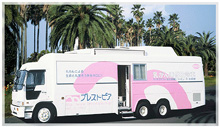
Mammo buses running nationwide
| 2020 | 2021 | 2022 | 2023 | 2024 | 2026 Target | |
|---|---|---|---|---|---|---|
| Stomach Cancer Screening Rate | 47.0% | 46.7% | 46.5% | 45.5% | *To be released in Sep 2026 | 60.0% |
| Colorectal Cancer Screening Rate | 79.9% | 80.3% | 81.0% | 81.5% | *To be released in Sep 2026 | 80.0% |
| Breast Cancer Screening Rate | 71.7% | 72.3% | 72.2% | 72.8% | *To be released in Sep 2026 | 80.0% |
| Cervical Cancer Screening Rate | 33.1% | 34.9% | 36.5% | 38.4% | *To be released in Sep 2026 | 60.0% |
Health literacy
< Mental and Physical Health >
Every year, we conduct self-care training for all employees and line-care training for managers, followed by a test to confirm their level of understanding. Health seminars are held by public health nurses from Group companies, covering topics such as disease prevention, lifestyle, nutrition, exercise, and mindfulness. QOLism, a health app used by approximately 80% of employees are registered, provides online seminars and videos on exercise, as well as information on diet, sleep, stress, and other topics. In addition, we have held seminars for management and employees by the chairman of the National Center of Neurology and Psychiatry, with whom we have a comprehensive partnership, to promote proper understanding of preventative measures and illnesses to create a better work environment.
| 2020 | 2021 | 2022 | 2023 | 2024 | 2026 Target | |
|---|---|---|---|---|---|---|
| Self-care training participation rate*1 | 96.3% | 95.1% | 98.0% | 98.1% | 98.1% | 100.0% |
| Line care training participation rate*2 | 95.8% | 95.2% | 93.6% | 95.5% | 96.5% | 100.0% |
- *1 Content: Balancing family and medical treatment, healthy lifestyle, stress management, women's health, etc.
- *2 Content: Mental health/line care, support for balancing work and family, women's health, self-care for subordinates
< Balancing Health and Work >
Since the Dai-ichi Life Group has a high percentage of female employees, we consider women's health to be one of the most important health issues. We conduct various seminars to help employees build a career that is unique to them by deepening their understanding of women's specific health issues and treatment, and improving their own and others' literacy.
< Themes for the fiscal years 2021-2023 >
Women's cancer / uterine disorders / premenstrual syndrome / dysmenorrhea / menopause / infertility
Menopause in men and women / Fertility treatment and egg freezing / Male menopause
< Joint seminars with other companies >
In FY2022, we co-sponsored a seminar with other companies that took menopause, a common symptom shared by many men and women, as a starting point, and mixed it with a panel discussion by outside experts and management. A wide range of employees, regardless of gender or age, participated, and surveys showed that approximately 90% of participants were satisfied with the seminar.
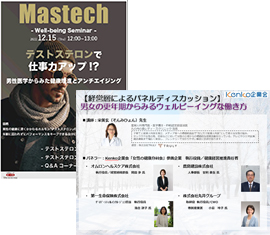
< Dai-ichi Life Insurance WOMAN's Day >
In FY2023, Dai-ichi Life Insurance WOMAN's Day was held in conjunction with International Women's Day and Women's Health Week. By having the Group CEO take the stage and holding a talk event with a speech by an expert and the president of a business company, we provided an opportunity for each employee to think about "how to live and work in their own way" and "what support they can provide to the colleagues they work with," from their own, their supervisors', and their colleagues' perspectives.
Exercise and diet
In fiscal 2016, we introduced a "healthcare point system" to provide incentives for each employee's efforts to improve their health, and in October 2021, we shifted to "QOLism", a new health promotion app developed by a Group company, to promote employee health by holding company-wide team competitions and other walking events, recording meals, measuring abdominal circumference, and providing a variety of other content, The application is helping employees improve their health by holding walking events such as company-wide team competitions, and by providing various contents such as diet records, measurement of abdominal circumference, and exercise. According to a survey of users, 89% of them improved their exercise habits by using the app. Similarly, 71% improved their eating habits through the application.
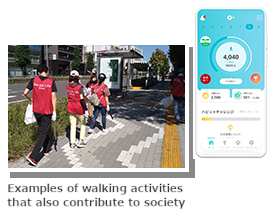
| 2020 | 2021 | 2022 | 2023 | 2024 | 2026 Target | ||
|---|---|---|---|---|---|---|---|
| Health Care Point Enrollment Rate | 76.7% | 73.9% | 79.4% | 80.6% | 79.9% | 80.0% | |
| Percentage of people who are regular exercisers*. | Men | 54.5% | 53.6% | 55.0% | 54.4% | 38.2%* | 50.0% or more |
| Women | 38.1% | 36.0% | 36.2% | 34.9% | 19.0%* | 40.0% | |
- * The percentage of employees who have continued exercising for at least 30 minutes, at least twice a week, for over one year (for fiscal years up to 2023, the percentage reflects those who continued this routine for over one month).
Smoking cessation support
We have designated the days that fall on a "2" (2nd, 12th, and 22nd) of each month as "No Smoking Days" and actively conduct anti-smoking awareness activities, such as posting posters to remind employees of the importance of quitting smoking. We also provide support for employees who wish to quit smoking by offering an app-based smoking cessation support program and subsidizing all out-of-pocket expenses for smoking cessation visits.
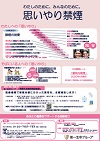
| 2020 | 2021 | 2022 | 2023 | 2024 | 2026 Target | ||
|---|---|---|---|---|---|---|---|
| Percentage of Smokers | Men | 27.7% | 27.9% | 27.3% | 27.7% | 27.7% | 23.0% |
| Women | 23.7% | 22.8% | 22.2% | 21.9% | 21.7% | 20.0% | |
Mental Health and Engagement Improvement
We have positioned "mental health measures" as one of our priority initiatives, aiming to realize the wellbeing of all employees. The "Improvement of Engagement" is one of the specific measures we are working on.
For details of the engagement score, please refer to "Final Evaluation Indicators for Health Management".
< Domestic Examples >
As a result of stress checks conducted every year, we offer interviews with doctors and consultations with public health nurses to employees with high levels of stress, and also provide the results of workplace-based analysis to the head of the department. In addition, through efforts to raise employees' awareness of stress and encourage self-care, we strive to prevent deterioration and recurrence of stress by early detection and early response. In addition, we are working to improve communication within the workplace through regular "1 for 1"*1 meetings between supervisors and subordinates, and we provide 1 for 1 training to supervisors as part of our efforts to strengthen management skills.
| 2020 | 2021 | 2022 | 2023 | 2024 | 2026 Target | |
|---|---|---|---|---|---|---|
| Stress Check Participation Rate | 84.5% | 83.8% | 81.2% | 86.3% | 90.3% | 90.0% |
| Percentage of High-Stress Employees | 11.1% | 13.5% | 14.9% | 14.7% | 15.6% | 10.0% |
In addition, we have made the "KOKOROBO®" (an online mental health care system using smartphones and PCs) provided by the National Center of Neurology and Psychiatry (NCNP) known throughout the company to prevent mental health problems and provide early treatment for those who have mental health problems.
In addition, in order to further contribute to solving issues related to mental health, we are participating in a collaborative project with NCNP entitled "Development of a Mental Health Platform Using the 'KOKOROBO-J' Remote Mental Health Care System for All Ages and Nationwide Implementation Bases"*2.
In addition, we offer a range of welfare benefits as part of our efforts to improve employee engagement. One example is the "Benefit Station" provided by Benefit One, Inc., which joined our group in 2024. This is a membership-based discount service, and we have introduced it as a welfare benefit system for all employees*3, including not only office-based workers but also sales representatives.
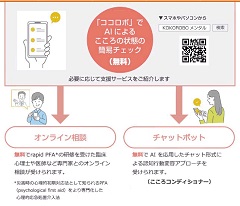
- *1 Name of Dai-ichi Life's version of "1 on 1 meeting"
- *2 Click here to see the activities of the "KOKOROBO-J" remote mental health care system for all generations.
- *3 This is applicable to those who have entered into an employment contract with Dai-ichi Life. Part-time contract employees are excluded.
< Example of an Overseas Representative Case Study >
Protective Life Corporation (PLC) offers a comprehensive range of benefits that support wellbeing, including office amenities, and will introduce a more comprehensive Employee Assistant Program (EAP) with a new provider in 2022. The EAP offers a variety of measures to help employees and their families improve their mental health, from in-person counseling to online therapy. We also leverage information provided by EAP providers from peer engagement survey results to support employees' personal and professional development. This is double the typical usage rate of similarly sized companies in the same industry.
Against long working hours
At our company, the prescribed working hours are set at seven hours per day. Any working hours exceeding this threshold are subject to overtime pay, which is ensured without exception-demonstrating a commitment that exceeds legal requirements.
In addition, employee working hours are managed based on computer log data. We have also established internal standards for working hour management that are stricter than legal regulations, as part of our efforts to eliminate excessive working hours.
For details on specific initiatives to reduce total working hours, please refer to the "Work-Life Management" section under Diversity, Equity & Inclusion.
For employees, including management-level staff, who work beyond a certain number of hours, we conduct interviews with occupational physicians to assess their overall health condition. When necessary, the relevant department heads and the Human Resources Department work together, in collaboration with the executive officers responsible for those departments, to improve the working environment. We also coordinate with the internal audit department to ensure appropriate working hour management through regular monitoring and related measures. Updates on monitoring results and appropriate labor management efforts are regularly reported to the Group Chief Human Resources Officer (G-CHRO) to promote sound management of working hours.
Infection control
In preparation for emergencies such as pandemics, we conduct annual in-house training on infectious diseases and have prepared related regulations, standards, action plans, stockpiles, etc., which are reviewed on a regular basis. In addition, in accordance with the Infectious Disease Control Law, we issue internal notifications of standards for responding to outbreaks of infectious diseases such as tuberculosis, measles, and rubella, and ensure that timely and appropriate reports are made to our administrative office to prevent the spread of infection and ensure stable business continuity. In the event of a pandemic, an Infectious Disease Response Headquarters consisting of management, corporate planning, human resources, and occupational health staff was established to flexibly discuss the situation and implement various measures based on the Business Continuity Plan (BCP).
Occupational Accident Countermeasures
Major occupational accidents at our company are mainly caused by stumbles and falls on station stairs and roads while commuting to and from work or while out of the office, and no serious accidents have occurred. In addition, we have not received any citations for serious violations of laws and regulations from the Labor Standards Inspection Office or other relevant authorities. In addition to taking timely measures to ensure safety and eliminate risks through regular workplace inspections at workplaces by industrial physicians and health managers, risk factors are regularly identified based on the results of analysis of the occurrence of occupational accidents, and recurrence prevention education is provided to all employees. In light of the recent increase in telework, guidance on the working environment for telework is also included in the training opportunities. These are investigated and discussed by the Health Committee in order to prevent occupational accidents. In addition, the company regulations stipulate that the company must accurately and in detail ascertain the circumstances of the accident and the treatment of the person involved, instruct appropriate measures in accordance with the details of the accident, and promptly report the accident to the department in charge. Based on the details of the report, the company identifies the cause of the accident by interviewing the victim and conducting an investigation, and submits a report to the Labor Standards Bureau as required. Regarding disasters, in accordance with the "Disaster Prevention and Response Regulations" approved by the Board of Directors, the Large-Scale Disaster Risk Management Committee submits training plans, issues, and initiatives to the Executive Committee. In addition, we regularly hold training sessions on disaster preparedness and use the "Emergency Call (EMC)" system to encourage employees to stay home or return home early in the event of an expected typhoon or heavy snowfall, and to confirm the safety of employees and their families after a disaster strikes. In preparation for the sudden cardiac arrest of employees or visitors, we have installed AEDs at each of our offices, and when they are installed, we conduct training sessions for employees on how to use them and provide information on their use at all times.
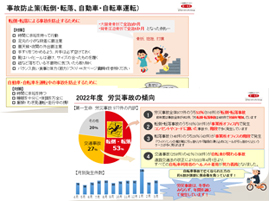
| 2020 | 2021 | 2022 | 2023 | 2024 | |
|---|---|---|---|---|---|
| Number of commuting accidents ( ) includes those with time off work |
201 (53) | 258 (55) | 271 (67) | 242 (62) | 262 (57) |
| Number of work-related accidents ( ) includes those with time off work |
568 (104) | 755 (141) | 663 (126) | 734 (121) | 644 (113) |
Establishment of a consultation service
We have set up a health consultation window for internal and external specialists so that employees can feel free to consult with them, and we are making this information known to all employees. Within the Group, we have industrial physicians specializing in internal medicine, surgery, psychiatry, etc., and public health nurses registered with the Occupational Health Nursing Specialist System of the Japan Society for Occupational Health, as well as other specialists. In addition, we have a system in place that allows physicians, health counselors (public health nurses, nurses, care managers, etc.), psychological counselors, etc. to provide support for external contacts. As for external contact points, we have set up a telephone hotline for health, medical care, nursing care, childcare, mental health, etc., and a web-based consultation service specializing in women's health, where you can obtain answers and advice based on the professional experience and knowledge of active obstetricians, pediatricians, and midwives (for male partners, we have set up an online consultation service for female partners). (Men can also consult about their partners). Both consultation services are free of charge, 24 hours a day, 7 days a week. Furthermore, based on the belief that the well-being of family members leads to the well-being of employees, the external consultation services mentioned above are available not only to employees but also to their family members.
Balancing Work and Medical Treatment
We believe that "balancing work and medical treatment" at the company will not only ensure the health of workers, but also improve their sense of security and motivation, and help them achieve a better work-life balance. We are also actively developing initiatives for early detection of illnesses. In addition, we provide support for returning to work and health counseling by industrial physicians and other specialists to ensure a smooth balance between treatment and work. Most recently, at the initiative of a volunteer cancer survivor, we have been engaged in peer support activities. This is a place for employees (who wish to do so) to share their experiences and thoughts about their illnesses and treatments, and to support, encourage, and exchange information with each other, which leads to "motivation" for treatment and work.
Track record
Health Management Evaluation Indicators
The Dai-ichi Life Group has designated "Engagement" and "Presenteeism" as Key Goal Indicators (KGIs), and also places great importance on "Absenteeism." In fiscal year 2024, we actively promoted initiatives aimed at improving these indicators, starting with enhancing engagement. These efforts have contributed to improved scores and progress toward achieving our goals.
< Three evaluation indicators >
| 2022 | 2023 | 2024 | 2026 Target | |
|---|---|---|---|---|
| Engagement*1 | 64 | 65 | 66.3 | 67 |
| Presenteeism*2 | 24.0% | 23.4% | 23.3% | Less than 20.0% |
| Absenteeism*3 | 2.5 | 2.2 | 2.2 | - |
< Absenteeism rate >
| 2020 | 2021 | 2022 | 2023 | 2024 | |
|---|---|---|---|---|---|
| Absenteeism rate*4 | 0.87 | 1.22 | 1.25 | 1.23 | 1.29 |
- *1 Wevox survey: Overall score (10-100 points) Number of people surveyed (response rate) : 2022: 52,906 (response rate 68%) / 2023: 50,974 (response rate 70%) / 2024: 51,518 (response rate 75%)
*includes domestic group companies (last survey of the year) and includes long-term absenteeism - *2 Employee survey: SPQ (Single-Item Presenteeism Question: University of Tokyo 1-Item Version)
Number of people surveyed (response rate): 45,604 (response rate 90.4%) *Excludes long-term absenteeism. - *3 Employee survey: "How many days did you take off work in the past year due to your own illness?"
Number of people surveyed (response rate): 45,604 (response rate 90.4%) *Excludes employees on long-term leave. - *4 Number of days not worked due to some form of inability to work / Total number of working days
Health Issues and Main Effectiveness Verification
IndicatorsWe are working to improve the effectiveness of the PDCA cycle by monitoring and verifying the effectiveness of the following specific initiatives, their implementation status, and changes in employee awareness and behavior over time using numerical data. Among the targets set by the Health Management Promotion Team, the percentage of employees who exercise and the smoking rate are on an improving trend.
Collaboration with other companies
Confirmation and recommendation of health management and occupational health and safety initiatives
When outsourcing operations, we recommend that our contractors promote initiatives related to occupational health and safety-such as improving employees' physical and mental well-being and addressing excessive working hours-aligned with the efforts undertaken by our domestic group company. We also require them to submit a "Sustainability Assessment Sheet" as part of this process.
Corporate Action for Cancer Control Promotion
We are participating in the Ministry of Health, Labour and Welfare's "Cancer Control Promotion Corporate Action" as an advisory board member, and we are also a member of the Work-Life Balance Support Subcommittee of the Consortium 40, a group of leading companies, and we are working with other member companies to promote cancer control measures in the workplace.
Kenko BusinessAssociation
As a director company of the Kenko Kigyo-kai (Health Company Association), which was established by companies that are actively working to improve the health of their employees, we are involved in the management of the association, and we also belong to the Data Health Subcommittee. Through information exchanges with member companies, we are also working to further improve our collaboration with health insurance associations and our health management initiatives.
External evaluations and awards

In 2013, our efforts were recognized when we received the Health Bureau Director-General Award at the 2nd "Let's Extend Healthy Life Expectancy!" Awards*1, hosted by the Ministry of Health, Labour and Welfare. In addition, in 2015, 2024 and 2025, we were selected as a "Health Management Brand Stock*2" jointly selected by the Ministry of Economy, Trade and Industry and the Tokyo Stock Exchange, and in 2017-2025 we were selected as a "Health Management Excellent Corporation (Large-Scale Corporation White 500)*3" for nine consecutive years. In addition, the company has also been consecutively certified as a "Sports Yell Company"*4 by the Sports Agency since 2017, and in 2025 we were certified as a Silver. In addition, it was selected as a "2023 Excellence in Cancer Control Corporate Action" by the "Cancer Control Corporate Action" promoted by the Ministry of Health, Labour and Welfare.
- *1 "Extend your healthy life expectancy! Awards" are presented to companies, organizations, and municipalities that are making outstanding efforts to raise awareness of lifestyle disease prevention and promote health in relation to the Smart Life Project's four themes: "moderate exercise", "proper diet", "smoking cessation", and "health checkups and medical examinations".
- *2 The Ministry of Economy, Trade and Industry and the Tokyo Stock Exchange jointly selected companies that consider the health management of their employees from a managerial perspective and are strategically engaged in it as "health management issues. Health Management" is expected to revitalize organizations by increasing employee vitality and productivity, which in turn will lead to improved business performance and stock price.
- *3 "Large-Scale Corporations White 500" are part of the "Excellent Corporations for Health Management" certified by the Ministry of Economy, Trade and Industry, and only the top 500 corporations in the Large-Scale Corporations category are certified.
- *4 "Sports Yell Company" is a certification system established by the Sports Agency to support companies that support and promote sports activities to improve the health of their employees.
Contribution to the community and society
Customer seminars (nationwide) Collaboration with local governments and national centers
We collaborate with all six national centers (National Center for Advanced Medical Specialties) in Japan to provide health and medical information through tools and seminars for a wide range of generations, from the three major diseases (cancer, cardiovascular disease, and cerebrovascular disease), diabetes, hepatitis, and infectious diseases, to medical care for pregnancy, childbirth, child rearing, and longevity such as dementia. As of the end of March 2025, we have signed comprehensive cooperation agreements with 44 prefectures and more than 430 municipalities, contributing to the resolution of social issues in communities across Japan.
Health Promotion and Donations
We are engaged in an initiative that utilizes the health promotion app QOLism, through which healthcare points accumulated by employees' wellness activities are donated to the Japanese Red Cross Society.
"Run with You" project to support citizen runners nationwide
By sponsoring marathons that represent the area and providing opportunities to think about health and experience the joy of running with others, we support the realization of "well-being" by enabling citizen runners nationwide and everyone involved to lead affluent and healthy lives.
Support for health insurance associations to optimize medical costs
We provide "Healstep®", a one-package service for health insurance societies to support the optimization of future medical costs and efficient management of health services, with the aim of solving social issues such as "widening gap between average life expectancy and healthy life expectancy". The number of health insurance societies that have adopted Healstep® is steadily increasing, and we have begun offering the service to employers as well. We will continue to provide support tailored to the needs of health insurance associations and employers.


